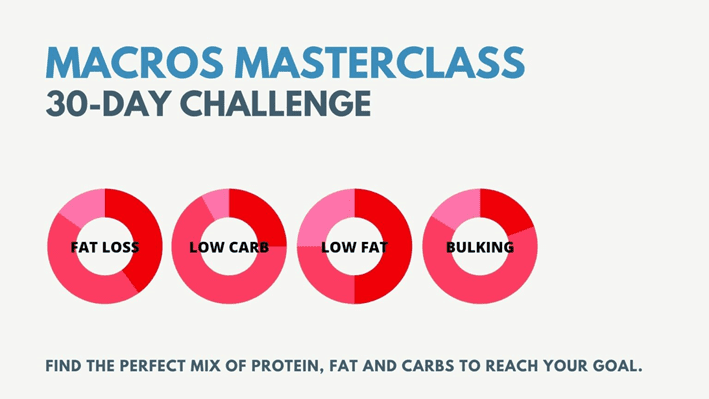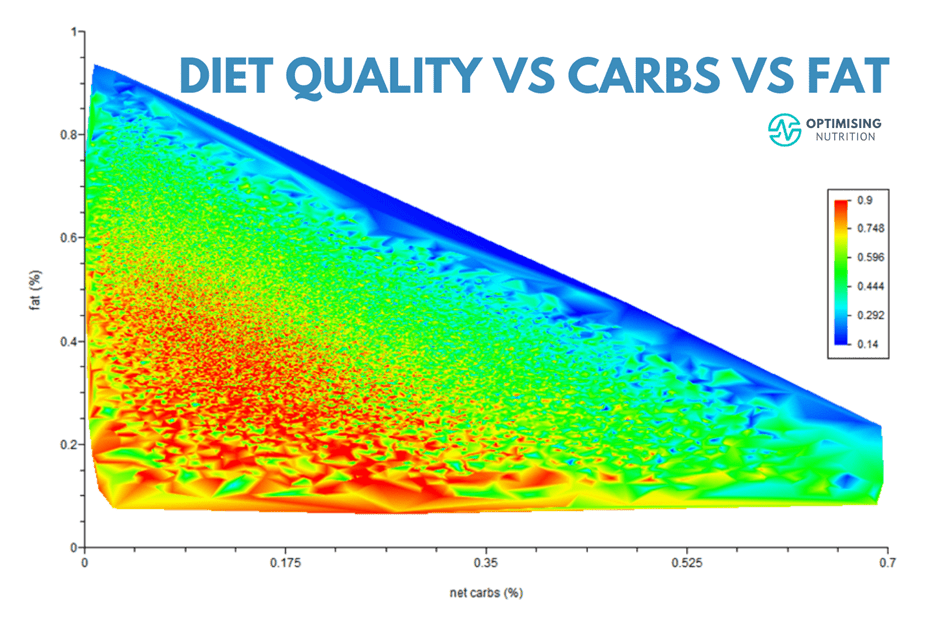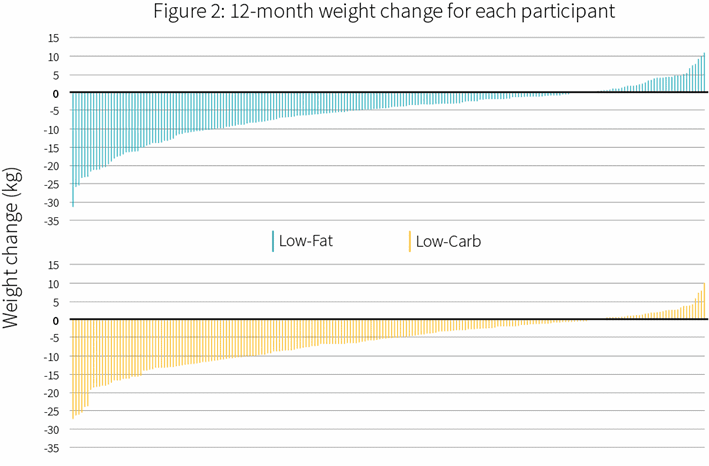Decades-long debates have put low carb vs low fat diets in a relentless tug of war to claim the throne for the most effective approach to weight loss and nutrient optimization.
With the medical community traditionally favouring a low-fat diet and recent years seeing a rise in the low-carb advocates, the confusion only deepens.
This article delves into an extensive analysis based on a whopping 150,000 days of food logging from 40,000 individuals, shedding light on which dietary extreme holds merit in the realms of weight loss, satiety, nutrient density, and long-term adherence.
The insights unearthed here aim to guide you towards a balanced dietary regimen tailored to your unique goals and preferences, steering clear of unproductive and unsustainable extremes.
Uncover the data-driven verdict to make an informed stride towards your health and wellness journey.
- Executive Summary
- Weight Loss & Satiety
- Is Low-Carb or Low-Fat More Nutritious?
- Is a Low-Carb or Low-Fat Diet Harder to Maintain?
- Changes in Fat and Carbohydrates Over Time
- Is A Low-Carb Diet Healthier than Low-Fat?
- Is It Easier to Get Enough Protein on a Low-Carb vs Low-Fat Diet?
- What Should I Eat?
- Summary
- More
Executive Summary
- There are pros and cons of fueling with carbs vs fat, depending on your context.
- While carbohydrates can be helpful to fuel explosive activity, you won’t need as much if you’re not so active and your blood glucose levels are already elevated.
- Conversely, while fat is a great fuel source for everyday use, you won’t need as much if you have body fat you want to lose.
- Rather than swinging from one extreme to another, the key is prioritising protein and nutrients while dialling in energy from fat and carbs to suit your goals.
Weight Loss & Satiety
The chart below was taken from our satiety analysis. Here, we can see that a lower percentage of total calories from fat aligns with a decreased calorie intake. Optimisers who consume a very low-fat diet tend to consume 37% fewer calories than those on a very high-fat diet.
At this point, the low-fat diet is looking favourable! However, the story gets a little more interesting when we look at our satiety response to carbohydrates.
The chart below shows we eat the most when our diet contains around 45% non-fibre carbohydrates, and most of the rest of our energy comes from fat. However, we see a 23% reduction in calories when we lower our consumption of non-fibre carbs to 10-20%.
The satiety response to carbs gets even more fascinating.
- On the far left, people tend to eat more if they eliminate carbohydrates completely. This is because your body likes to use carbohydrates for fast-burning fuel and to keep blood glucose from dropping too low. Additionally, ‘zero-carb’ foods (i.e., animal-based foods and oils) tend to be lower in certain minerals critical for satiety. Hence, small amounts of carbohydrates satisfy these cravings quickly and stop us from continuing to eat in search of enough glucose, and non-starchy vegetables contain some of the nutrients and fibre we crave that put the brakes on our appetite and slow digestion.
- On the far right of the carbohydrate vs calories chart, we can see that we tend to eat a bit less if we reduce fat and increase our intake of non-fibre carbohydrates beyond 50%. However, this is not easy for most people to achieve, and most people tend to gravitate back towards the hyper-palatable mix of fat and carbs.
The following chart shows the satiety response to fat vs carbs together. As you can see, reducing fat has the most significant impact on your overall calorie intake. However, moving from a moderate to lower carbohydrate intake can also help with satiety.
That said, many people get into trouble when they swing from one extreme to another and simply swap carbs for fat.
So, what do we eat if we can’t swap fat for carbs (or vice versa)?
The following chart, which includes protein and fibre, gives us a clue.
- Reducing fat itself aligns with consuming nearly 37% fewer calories.
- However, reducing carbs can allow someone to lower their calorie intake by almost 23%, and increasing the percentage of our total calories that come from protein (i.e., protein %) aligns with a massive 61% reduction in calories consumed!
- Additionally, foods containing more fibre are also challenging to overeat.
While this may motivate you to jump from low to high protein overnight, it might not be the best solution if your goal is weight loss. Instead, it’s ideal to understand how you’re currently eating so you can use that information to progressively dial back your fat and (or) carb intakes while prioritising protein.
Unfortunately, nutrition can sometimes be confusing. While we like to think in terms of carbs vs fat or low vs high, the reality is that lowering carbs or fat will impact the other variables, including protein. To illustrate, the chart below shows non-fibre carbs vs fat vs protein from our Optimiser data. Each dot on the chart represents a day of food logging.
- On the diagonal axis, we have days of food logging that are a mixture of fat and carbs and low protein % (blue area).
- Meanwhile, in the bottom left corner, we have days of logging that are low in fat and non-fibre carbs and have a higher protein %.
The next version of this chart shows carbs vs fat vs calorie intake for each of the points.
- We see that moving along the diagonal axis aligns with a higher calorie intake (red data points), regardless of whether we get more of our energy from fat or carbs.
- However, if we swap fat or carbs for protein, we get a lower calorie intake (blue area).
For more detail on these 3D surface plots, see The Geometric Framework for Nutrition: Nutrient Optimiser Data Analysis.
In our Macros Masterclass, we guide our Optimisers through dialling back their carbohydrate intake if their blood sugars rise by more than 30 mg/dL (1.6 mmol/L) after they eat. This indicates they’re overfilling their glucose fuel tank, and their body needs fewer carbs.
Once someone has stabilised their blood sugars—but not necessarily flatline—we can focus on reducing dietary fat so someone can use their body fat.
Is Low-Carb or Low-Fat More Nutritious?
When it comes to nutrient density, we see that a lower-fat diet tends to align with a higher Diet Quality Score.
As the micronutrient fingerprint chart below shows, getting adequate amounts of essential nutrients like vitamin C, vitamin K1, and niacin on a very high-fat diet can be challenging.
But interestingly, a lower-carb diet also aligns with a greater nutrient density.
While the nutrient density of very high-carb foods is slightly better than high-fat foods, they both have their own unique nutritional challenges. In contrast to high-fat foods, high-carb foods tend to lack vitamin B12, omega-3, and selenium.
When we plot the nutrient densities of all three macros together (i.e., the number of nutrients per calorie), we see that protein dominates. Thus, increasing the protein % of your diet to about 50% of total calories will help you get more of all the essential nutrients.
The chart below shows the carbs vs fat vs diet quality. Again, we can see that reducing carbohydrates or fat can lead to a higher diet quality score, so long as we don’t simply swap carbs for fat. Instead, to increase nutrient density and satiety, we need to swap energy from carbs and fat for protein and fibre.
For more, see:
- What is Nutrient Density (and Why It Matters)?
- The Diet Quality Score: Your Ultimate Measure of a Balanced Diet
- The Geometric Framework for Nutrition: Nutrient Optimiser Data Analysis
Is a Low-Carb or Low-Fat Diet Harder to Maintain?
One common lower-carb diet critique is that it’s hard to maintain. You may be interested that the average Optimiser’s carbohydrate intake is only 17%. People focused on getting adequate protein and nutrients tend to gravitate towards a lower-carb diet naturally.
Although a higher-carb diet tends to be the most popular approach, many people successfully maintain a lower-carb diet, particularly if they are motivated to manage their diabetes and stabilise their blood glucose levels.
Meanwhile, the average Optimiser’s fat intake is 46%. Because protein usually comes packaged with some fat, it’s hard to reduce fat too much if you’re consuming adequate protein.
For reference, the average protein % of our Optimisers is 32%. However, there is a wide distribution of protein intakes, and our Optimisers eat anywhere from less than 10% to more than 60% of their total calories from protein.
But ultimately, it doesn’t matter if you prefer a low-carb or low-fat diet. So long as you get the protein and other nutrients your body requires without excess energy from carbs or fat, you aren’t bound to any one dietary avenue.
Changes in Fat and Carbohydrates Over Time
Finally, let’s examine how our carb and fat intakes have changed over time. An influx of carbs and fat has contributed to the massive increase in energy intake and obesity rates over the past half-century.
If we look at the changes in our diet since 1980, we can see a pronounced increase in carbohydrate intake until artificial sweeteners like Splenda were approved for widespread use around 1999.
Around this time, high-fructose corn syrup (HFCS) became unpopular amongst consumers due to its links to the diabesity epidemic. Innovative food manufacturers replaced HFCS with cheap and palatable ‘heart healthy’ seed oils and artificial sweeteners, flavours, and colours to create modern ultra-processed foods. As a result, our intake of high-calorie, low-satiety fats spiked, our carb intake decreased, and the obesity epidemic powered on.
Looking back over the past century, we see that our intake of both carbs and fat have increased since the agricultural revolution of the 1960s. Unfortunately, this added more empty calories to the food system.
Interestingly, the United States’s carbohydrate intake fell in the first part of the last century but has since risen to similar levels consumed 100 years ago. However, our fat intake has increased simultaneously by a whopping 800 hundred calories per person per day!
This massive increase in empty calories mainly comes from industrial seed oils like palm oil, soya bean, sunflower, canola, and rapeseed.
Increased food processing has made our diet a similar mix of fat and carbohydrates. This hyper-palatable combination is poorly satiating and might have you feeling ‘addicted to food’. Hence, it’s no surprise that it aligns with the maximum energy intake!
Food manufacturers are only too happy to sell us the hyper-palatable and hyper-profitable processed food products that we love to eat and buy!
Is A Low-Carb Diet Healthier than Low-Fat?
Many studies have compared the effects of low-carb vs. low-fat diets on health markers.
Because the reference ranges for ‘healthy’ blood markers are often based on a population consuming a lower fat diet, they are sometimes hard to interpret. For example, when consuming a lower-carb diet, many people are concerned with higher total cholesterol in their blood. However, higher blood fat levels should not be surprising if someone is eating more fat and fewer carbs.
Rather than swinging to extremes, adding back some dietary carbohydrates will often lower total cholesterol. But similar to mixing dietary fat and carbs, very high levels of fat and glucose in your blood simultaneously are dangerous. For more, see Cholesterol: When to Worry and What to Do About It.
It’s worth noting that your total blood lipids can rise when you lose weight because your body releases stored body fat into circulation. If you see this, you can repeat your blood tests once your weight has stabilised.
Studies show a lower-carb diet tends to improve HDL levels (i.e., ‘good cholesterol’) and has negligible effects on LDL (i.e., ‘bad’ cholesterol).
Additionally, lower-carb diets tend to improve blood sugar and insulin levels after eating, which tends to stabilise appetite and facilitate weight loss. However, many people fall into the trap of swapping carbs for fat, which may not lead to fat loss or lower blood sugar and insulin levels across the day.
Professor Christopher Gardner’s high-profile 2018 DIETFITS study showed the effectiveness of low-fat and low-fat diets alongside one another. When subjects were encouraged to follow a moderately low-carb or low-fat diet focused on whole foods, they saw similar results.
Another high-profile plant-based low fat vs ketogenic ad-lib study run by the NIH’s Kevin Hall had similar findings. When researchers fixed protein at 14% and pushed fat and carbs to extremes, the low-fat participants lost a little more weight. However, they also lost more metabolically active lean mass.
Is It Easier to Get Enough Protein on a Low-Carb vs Low-Fat Diet?
Online debates have run in circles for decades over low carb vs low fat.
Despite hundreds of millions of dollars of public and private money spent on studies trying to prove and disprove the Carbohydrate Insulin Hypothesis, it seems that most people are missing the most critical factor and the heaviest-hitting elephant in the room: protein.
Our data suggest that it doesn’t matter whether you prefer a lower-carb or a lower-fat diet, so long as you get enough protein.
People who need to stabilise their blood sugars tend to benefit more when they lower their carbohydrate intake. Meanwhile, people who do a lot of explosive activity often prefer more carbs and less fat.
But overall, your balance of fat vs. carbs doesn’t matter that much if your protein % is high enough.
So, the more interesting question becomes, ‘is it easier to get enough protein on a low-carb or low-fat diet?’
The chart below shows protein % vs fat % and carb % together. It seems you can get plenty of protein if you’re consuming a lower-fat or a lower-fat diet. For best results, you can even lower both.
Whether you prefer to reduce carbs, fat, or even both doesn’t matter much; so long as you get adequate protein and nutrients!
Maybe it’s time we moved on from the endless low carb vs low fat or plants vs animals debates and simply focus on giving our bodies the protein and nutrients they require to be satisfied and thrive.
What Should I Eat?
To help you identify what to eat, the chart below shows a range of popular foods across the carbs vs fat landscape. Green represents foods with a higher nutrient density, while brown represents foods with a lower diet quality score.
- If you want to reduce your carbs, you can prioritise more foods towards the left of this chart.
- If you want to reduce your fat, you should prioritise more foods towards the bottom of this chart.

To dive into the detail of this chart, you can check out the interactive Tableau version here. Simply mouse over the dots to see the details of each food.
You can also download our full suite of (free) nutrient focussed food lists tailored for a range of goals and preferences here. These simple food lists are a great way to start your journey of Nutritional Optimisation.
Finally, this chart shows where our six hundred NutriBooster recipes sit on the carbs vs fat vs nutrient density landscape.

Again, you can view the interactive Tableau version of this chart here to find recipes that align with your goals and preferences.
Summary
- Reducing fat or carbs aligns with improved nutrient density, satiety, and a lower calorie intake.
- Over the last half-century, the amount of energy we consume from both fat and carbs has increased. However, our carb intake over the long term has not changed significantly. Instead, our energy intake from fat—mainly from the addition of industrial seed oils—has increased by nearly 800 calories per person per day.
- Protein is the most satiating macronutrient. Hence, reducing fat and (or) carbs while prioritising protein will increase nutrient density, satiety, and weight loss.
- Whether you prefer a lower-carb or lower-fat diet doesn’t matter too much. So long as you get adequate protein and enough of all the other essential nutrients your body requires to suppress your cravings and improve your satiety, you can eat however you prefer.


























As far as personal fat threshold goes, I found this today: https://www.eurekalert.org/news-releases/965507
Nothin’ like a little vindication, huh? ?
Great to see more work being done in this area. Professor Roy Taylor’s work on the Personal Fat Threshold has been revolutionary in our understanding of the etiology of insulin resistance and diabetes.